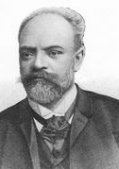
Antonin Dvorak
Musically speaking, the nineteenth cenury was without a doubt the century of the symphony. It had become the ultimate form of musical expression for the modern composer. Symphonies were longer, grander, more serious and more complex than anything that had come before.
And the titans of the symphony in that century were Beethoven, Schubert, Brahms and Dvorak. Brahms was commonly seen as the successor to Beethoven, and his music certainly continued his Romantic, expressive, Germanic style.
Dvorak was the first non-German composer of large-scale symphonies that became well established in the repertoire. Not only was he not German, his music incorporated Czech and Slavonic folk musical ideas, sometimes overtly quoted and sometimes just in style.
Brahms was the grand old statesman of the Romantic Symphony when Dvorak was just starting out in the world. The son of a butcher, and with little formal training, Dvorak began his carreer as a church organist and cafe violinist in Prague.
His composing was initially an ignored sideline, until Brahms began to champion the music of the young Czech. In time, Dvorak's nine symphonies, 15 string quartets and other chamber works grew in popularity and stature that by the time he wrote his seventh symphony, he was regarded as the successor to his mentor Brahms.
Dvorak's music, while just as complex as his predescessors, is noted for its rich melodies and harmonies that are characteristically Dvorak. He wrote nine symphonies spanning his entire life. The best known is the last, the so-called “
From the New World” which has unfortunately overshadowed the others. His last three symphonies are all masterpieces, with perhaps the seventh the greatest of them all.
The Seventh Symphony
Many regard Dvorak's Seventh Symphony as his greatest of all, and perhaps the pinnacle of his entire musical output. It was commissioned in 1884 by the London Philharmonic Society, Dvorak having been elected as a member that year, and so is sometimes known as Dvorak's
London Symphony.
Like all of his symphonies except for No.3, it follows the classical structure of four movements. This is a turbulent, frantic work, the darkest of all his large-scale works. The very famous third movement
scherzo matches that of Beethoven's Ninth in intensity and mood.
Yet it is still richly melodic, and there are frequent rays of happiness and tranquility. The horn solo in the middle of the first movement casts needed sunshine on the gloom, and the second movement
Poco adagio is especially serene.
With the
Seventh Dvorak had acheived what he had set out to do - write an emotionally balanced and complex work, fully worthy of Brahms' patronage.
The Eighth Symphony
In contrast, the
Eighth Symphony is a peaceful, happy piece. It is a walk in the Bohemian countryside, full of flute bird-calls and pastoral tranquility.
After his triumphant
Seventh Dvorak wanted to write a symphony for himself. He described it as “
different from the others, with individual thoughts worked out in a new way”. And different it is in tone, harmonies and development. I think of the
Eighth as a light summer breeze between two huge storms.
The Ninth Symphony - “From the New World”
Dvorak spent the years between 1892 and 1895 in America. People often comment on the “American-ness” of his final symphony, that its themes remind them of Negro spirituals or native Indian music.
Dvorak in fact said in a New York Herald interview in 1893 that having studied American Indian melodies, he tried to reproduce their
spirit in his new symphony.
“I have not actually used any of the melodies. I have simply written original themes embodying the peculiarities of the Indian music, using these themes as subjects, have developed them with all the resources of modern rhythms, harmony, counterpoint and orchestral colour.”
He was trying to demonstrate how people could employ the local Nationalist traditions within a modern framework, just as he had used “
half-forgotten tunes of the Bohemian peasants”.
But who are we kidding? The Ninth Symphony is as Dvorak and as Czech as anything he had written before. Had it not been written in America, or given its nickname, it is doubtful that anybody could make the negro spiritual or American Indian connection. It certainly uses simple folk-like melodies, but only to the extent that they exist in every folk tradition, be it Slavic or slave.
All of which is of little consequence. What Dvorak produced was one of the best-known and most-loved of all symphonies. Its gorgeous
Largo melody, the dramatic
Scherzo leading into the monumental
Finale are the stuff of musical icons. It is easy to love Dvorak's final creation in the genre.

Christoph von Dohnanyi
Christoph von Dohnanyi
This recording by the Cleveland Orchestra under Christoph von Dohnanyi was made in 1997, and has been a best-seller ever since. The superb interpretation has attracted critical acclaim, and the digital recording is bitingly crisp.
Best of all, the grouping of the greatest three Dvorak symphonies on two CD's for the bargain price of a single CD introduces two lesser-known symphonies in addition to the ubiquitous Ninth.
If you are familiar with just the
New World Symphony, treat yourself to two other greats. If you know all three symphonies, you will not find a better recording of the set.
Please support Good-Music-Guide.com
by purchasing this CD using this link.

Track Listing
Antonin Dvorak
Symphonies no.7, 8 and 9
(From the New World)
Cleveland Orchestra
Christoph von Dohnyanyi
Disc: 1
Symphony no.7 in D minor Op.70
- Allegro maestro
- Poco Adagio
- Vivace
- Finale: Allegro
Symphony no.8 in G major Op.88
- Allegro con brio
- Adagio
- Allegretto grazioso
- Allegro ma non troppo
Disc 2
Symphony no.9 in E minor Op.95 “From the New World”
- Adagio, Allegro molto
- Largo
- Scherzo. Molto vivace
- Allegro con fuoco
- Scherzo capriccioso for piano 4 hands